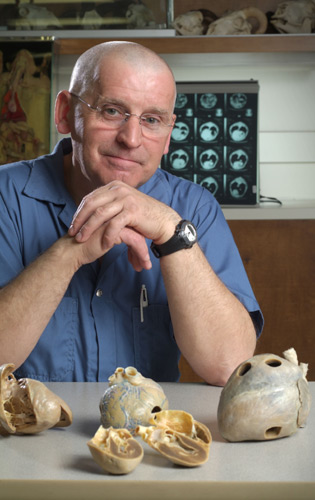
U of G chancellor Pamela Wallin probably doesn’t know it, but she had a voice in helping Roman Poterski and his young immigrant family to make their new life in Canada.
It was 1986, on the eve of Canada Day, when Poterski, his wife, Barbara, and their preteen daughter, Marta, arrived with their few bags, little money and no English. All going well, the former refugee will probably come face-to-face with the chancellor when Poterski finally receives his doctorate in the next year or two.
There’s a clue to his roots in his lingering accent. But little about the soft-spoken fifty-something in the Big Bill coveralls hints at the road he took to become a veterinary anatomy technician and instructor and a PhD candidate whose adviser is U of G president Alastair Summerlee.
During much of the academic year, Poterski helps to lead classes in the spacious ground-floor veterinary anatomy lab within the Department of Biomedical Sciences. Those classes give first-year DVM students ― about 110 each year ― their first inside look at vertebrate structures and systems from head to tail. Those classes involve hands-on dissections, but they also draw on a small museum’s worth of teaching tools Poterski has prepared during nearly 20 years in the nearby plastination lab.
Mention plastination, and many minds will conjure up Body Worlds. Since German anatomist Gunther von Hagens invented his plastination technique in 1977, millions of people around the world have seen his travelling exhibition of preserved human bodies and organs. That show has sparked both praise and controversy for bringing anatomy and physiology to the masses.
Poterski isn’t interested in praise or controversy. He says plastination of animal organs allows his department to teach numerous students while reducing the number of dissections needed in that vet anatomy lab and in related courses in the Ontario Veterinary College (OVC). For either vet anatomy dissections or plastination, Poterski uses animals and parts donated to OVC for research and teaching.
He says animal skulls and skeletons are relatively easy to keep as specimens, but internal organs and similarly degradable parts are normally a different matter. By replacing water and other liquids in those organs with silicone, plastination allows anatomists to preserve body parts for display and handling ― without decaying or smelling ― for decades.
Poterski has adapted von Hagens’ four-step plastination method of embalming, dehydration, silicone impregnation and curing. The process takes place from start to finish on campus, including the critical step of forced impregnation, or drawing in silicone within a vacuum chamber to replace liquids in cells. Unlike von Hagens, who conducts impregnation in freezing conditions, Poterski uses chemicals that allow him to work at room temperature. Along with Summerlee, he wrote an article about a new way to preserve lungs for the Journal of Plastination in 1993.
Horses, cows, sheep, pigs, dogs: most common agricultural animals are represented in the collection. Besides its plastinated specimens, the collection also includes transverse sections ― basically slices of organs or entire systems moving from one end of the animal to the other ― that students use alongside CT scans to gain different kinds of insights.
A plastinated specimen allows students to learn how tissues and organs are organized, says Prof. Pavneesh Madan, Biomedical Sciences. “With plastination done in a proper manner, you can show those layerings and how it was placed in the body.” Unlike a dissected stomach or bladder, “it will hold its shape and form and will not collapse.”
There was no straight line to plastination or anatomy from Poterski’s roots in Gniezno, the ancient capital of Poland. There he studied animal husbandry and leather tanning. By 1985, he and his wife ran a small garment-cleaning business.
Poland’s military government had lifted martial law by then, but Poterski was worried that he might still be arrested for his involvement with the Solidarity movement. He and Barbara were being watched by police at home and at work.
“They isolated us.” Seated in the OVC cafeteria, he pauses and sighs: “We were simply given the choice ― leave or go to jail. The choice was obvious.”
After a bus ride to Germany, the family spent several months in a refugee camp. There they pondered possible destinations. Canada won out, not least because of the folk-hero status that many Poles accorded then-prime minister Pierre Trudeau and other Canadians.
They arrived in Chatham, Ont., on the last day of June 1986. The next day, “we woke up to the sounds of the Canada Day parade, and some strange people offered us beer and hamburgers,” says Poterski.
It took eight-year-old Marta little time to get used to their new home. But for Roman and Barbara, it was a longer road that included English-language classes ― and some help from today’s U of G chancellor.
“Pamela Wallin was on the news, so I was learning from her on TV. Her pronunciation and the way she speaks were so clear,” he says.
They moved within a year to Kitchener, which is still home. Working for a commercial painting company, Roman found himself at OVC painting a surgical suite. He left a job application at the college and was hired in 1987 to clean labs and animal facilities in Biomedical Sciences.
A year later, Prof. Alastair Summerlee arrived in the department, and Poterski began working as a technician in his lab. Poterski earned a master’s degree in 1995, studying hormonal effects on pregnancy in mice. Since then, he’s spent about a decade on his PhD. He’s looking at how the relaxin hormone might benefit stem cell transplants, perhaps helping to prevent rejection of donated tissues.
Along with his adviser and other co-authors, Poterski has published about 30 peer-reviewed papers and has four more in press.
Marta completed a psychology degree at Guelph in 2002 and works as communications manager in the University of Waterloo’s graduate studies office.